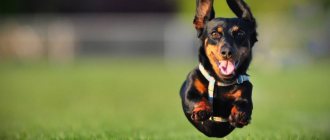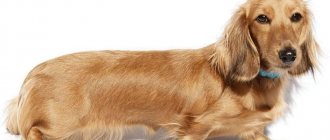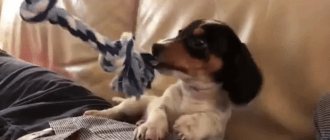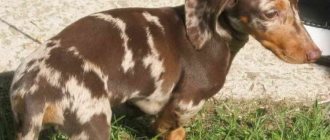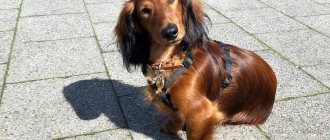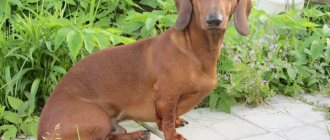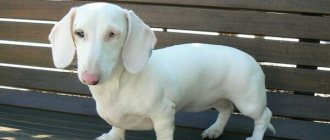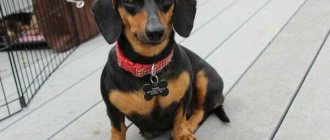The Dachshund dog is the oldest hunting breed that has gained popularity as a companion. The uniqueness of the animal lies in its elongated body, which gives it a funny appearance. Thanks to the film “Four Taxi Drivers and a Dog,” where the main character is a dachshund named Figaro, interest in this breed has grown greatly in Russia.
In this picture, the dog turned upside down not just one apartment, but an entire taxi fleet. To prevent something similar from happening to the owner’s house, the owner of the dachshund must certainly keep his pet busy with useful activities and devote sufficient time to his upbringing.
Dachshund dog: a brief history of the breed
Germany is recognized as the birthplace of the breed, where the dachshund dog is called “Dachshund” (“badger hound”). The animal received this name thanks to the main object of hunting that ravaged German lands - badgers.
Breeders received a new breed in the 16th century during the selection of individuals with short legs among hound marriages. The long body and powerful paws allowed the hunting dachshund to climb into a hole and “smoke out” not only badgers, but also foxes.
The main advantages of the new breed were represented by the following qualities:
- Analytic mind. The dog, left alone with the wild animal, made a decision independently, depending on the situation.
- Compact sizes. The dachshund had no problem chasing and dodging the attacks of hunted prey. Larger breeds were injured in narrow tunnels.
- Fearlessness. The dog was not afraid of large opponents and demonstrated a strong grip.
This is interesting! According to archaeological excavations, dachshund dogs existed in ancient Egypt. The short dogs found on the frescoes vaguely resemble the modern standard. The theory has not been confirmed by the FCI, so the breed is assigned to Germany.
By the end of the 17th century, the breed spread throughout Europe, and in the 70th year of the 19th century it received official recognition and an approved standard.
True Aryans
The homeland of small dachshunds is Germany. Once upon a time there were hunters. Part-time breeders. And they decided to take the dog out. Such that it would hunt burrowing animals. And this means small, bold and vocal.
The hunters thought and decided: let's breed something similar to brakk. Brakk is a breed of dog. She became the ancestor of the miniature dachshund. Although no, its ancestor was the common dachshund.
And it happened like this. First, breeders paid attention to the Bracq mutation. Some puppies were born with short legs. The body is normal, but the legs are crooked and short. So they became the progenitors of the dachshund.
The breeders didn't stop there. They have made attempts to reduce the dogs. The fruit of their labors was a mini-dachshund. This happened at the end of the 19th century. Since then, the dog has gained wild popularity around the world.
Interesting facts about dachshunds
- The charming short-legged dogs were favorites of the imperial and royal families. For example, the last German Emperor Wilhelm II had 5 dogs of this breed.
- The breed's popularity declined sharply during World War II. In the cartoons, dogs were compared to Nazis, portraying them as aggressive and narrow-minded.
- The Nazis claimed that they had developed a telepathic gift in representatives of the breed.
- The German dog became the second Olympic mascot. Unlike the Red Jaguar from Mexico City, the mascot from Germany received recognition.
- One of the representatives of the breed became a participant in cloning, repeating the experience of the dog Snoopy. The organizers of the project were Koreans.
Breed description, standards and appearance
The dachshund is a strong, heavily boned dog that stands firmly on the ground, with a long, elongated muzzle and long, soft ears. The tail, thick and strong at the base, is set low, usually carried slightly below the line of the back, but when excited it sticks out like an antenna. The main distinguishing feature is short thick legs with prominent muscles.
This is interesting! For several centuries, the high price allowed only royal and wealthy families to keep the breed.
The Dachshund standard approved by the FCI applies to all varieties:
- Soft, drooping and rounded ears. Dachshunds with pointed or protruding ears are considered a defect.
- Wedge-shaped head with a long and pointed muzzle.
- Pronounced brow ridges.
- Oval eyes of medium size with a wide set. The Dachshund's exterior allows for any shade from the brown color palette. The exception is the merle-colored dachshund species. The eyes of these dogs can be blue.
- Large black or brown nose.
- Large and powerful jaws with a scissor bite.
- Muscular and long neck with a slightly convex nape.
- Wide chest, muscular back and long loin.
- Short and slightly curved legs. Dachshunds have powerful limbs with hard and strong nails.
- Saber-shaped tail with a thick base and a sharp tip. The length of the tail should reach the end of the paws.
Depending on the size of the dachshund there are:
1.Standard:
- males must weigh at least 7 kg, and females - at least 6.5 kg;
- height – 20–27 cm;
- chest circumference – no more than 35 cm.
2.Miniature or dwarf:
- the weight of a boy’s dachshund ranges from 4–7 kg, and a girl’s – 3.5–6.5 kg;
- height – 14–21 cm;
- chest circumference – 30–35 cm.
You can learn about the characteristics of dwarf dachshunds here.
3. Rabbit dachshunds. Dogs of this species are 2 times smaller than a standard dachshund. The dimensions of an adult rabbit-type dog are:
- weight – less than 3.5 kg in dogs and less than 4 kg in dogs;
- height – 10-15 cm;
- chest circumference – less than 30 cm.
Read in detail about the rabbit dachshund.
Important! The length of a dachshund depends on its type and height and ranges from 150-177 cm.
This is interesting! The Russian rabbit-type dachshund is a real rarity. The tiny size of this dachshund makes breeding difficult, so the number of breeders is kept to a minimum.
Depending on the species, a dachshund can have not only short and smooth hair, but also long and even fluffy hair.
Important! Smooth-haired and hairy dachshunds cannot be bred with each other. These are separate breeds.
Let's consider all the approved standards for the Dachshund breed depending on its coat type.
Dachshund dog - coat type and color
Based on coat type, the breed is divided into the following varieties:
- Smooth-haired dachshund. This species has a dense and hard coat of medium length. The coat should be shiny and close to the body.
- Long-haired. This breed of dachshunds has well-defined feathering on the hind legs and lower part of the tail. Hairy dogs are more demanding in grooming.
- Wire-haired dachshund. This variety has a hard and thick coat with a pronounced undercoat. This breed is distinguished by shaggy eyebrows and a peculiar “beard”.
Depending on their color, dachshunds are:
- Plain. Red and yellow dachshunds with a black nose are allowed. The palette also includes a cream-colored golden dachshund, reminiscent of a retriever.
- Two-color. The black dachshund always has an additional brown color on its paws, face and chest. There are also brown dachshunds that are rusty or chocolate in color with black accents on similar parts of the body. Black dogs always have a black nose and nails, while chocolate dachshunds are brown.
- Marbled, spotted, brindle. A dog with large spots that predominate over the main color is considered a defect. Small spots should be brown, black, yellow or gray. The brindle dachshund is less common than others and its color is predominantly red.
Important! The white dachshund is not included in the standard. This color occurs when breeding rules are not followed or a natural anomaly occurs. Sometimes the white dachshund is an ordinary albino.
Development in the first month
In the first month, wire-haired dachshund puppies grow very actively. The most important changes by day are presented in the table below.
| Days | Changes |
| 1-3 | Puppies cannot see or hear yet, but they have a developed sense of smell. |
| 4 | The sense of smell increases and hearing begins to appear. |
| 5-7 | The nasal lobe turns dark. |
| 8-9 | Body weight begins to actively increase. |
| 10-14 | The eyes open, the puppy learns to move independently. |
| 15-20 | The first baby teeth appear. |
| 21-30 | The puppies begin to move more and become more active. |
Dachshund dog - character and behavior
The brave and decisive character of a dachshund boy makes him a more skillful and proactive hunter. Girls have a softer character than boys, so they are rarely purchased for hunting.
The character of a dachshund has the following traits:
- Devotion. The animal quickly gets used to its new owner and needs constant attention.
- Playfulness. It is difficult for a pet to sit in one place. A restless dog resembles a perpetual motion machine.
- Mind. Developed intelligence. The breed is stubborn and loves to do things its own way, so the OKD course will be a real salvation for the new owner.
- Fearlessness. Despite its modest size, the brave pet is always ready to protect its owner. The main instrument in the dispute is a loud bark, not inferior in volume to larger dogs.
Important! The dog's hunting habits include a love of swimming. Try to take your pet out into the fresh air for swimming and jogging in the forest.
Expert opinion
Leonid Rodin
Experienced dog breeder
Ask a Question
It can be assumed that those wishing to purchase a dachshund know its character and habits well. But practice shows that this is not so. For many, the following fact will be a revelation: in 2008, experts from the American publication Applied Behavioral Science of Animals included the dachshund in the list of the most aggressive and unfriendly dog breeds. The tenacity and perseverance of little German hunters sometimes led them to very unusual activities. In the 70s, dachshunds took part in dog racing for speed. Initially, the competition was organized in Australia, and later the tournament moved to San Diego (USA) and was very popular among spectators. The dachshunds did not win this competition. But the audience was amused by the passionate desire of the short-legged dogs to compete on equal terms with other participants. This is how the entire leadership character of dachshunds is manifested in a unique way. They definitely want to be first and in charge.
Dachshund and children
Representatives of this breed get along well with children, as they love outdoor games. But do not forget to explain to the kids the rules of behavior with animals.
How to choose a dachshund puppy?
In order to buy a healthy and purebred pet, consider the following factors:
- Conditions of detention. The nursery or breeder's home should be clean and spacious.
- Parents' appearance. If one of the parents has visible defects, then there is a high probability of their being passed on by inheritance.
- Number of puppies. The fewer babies in the litter, the more milk they get. The immune system of such puppies is very strong.
- Activity of the future pet. The puppy must be nimble and active. Avoid lethargic babies with poor coordination.
- Availability of documents. Purebred dachshunds are sold together with a package of documents certifying their belonging to the breed. When the breeder has vaccinated himself, a veterinary passport is additionally attached,
- Appearance of puppies. A healthy dachshund puppy should have a thick, shiny coat with no bald spots. Deflections and depressions on the body are not allowed. Discharge from the eyes or nose indicates an infection.
Important! At first, a dachshund puppy looks different from its adult counterparts. With age, the bright red color becomes less pronounced, and the rounded muzzle becomes sharper.
Depending on the class, prices for puppies in Moscow vary from 10 to 30 thousand rubles.
Causes of premature death
The most common cause of premature death in dachshunds is a viral disease. More than 40% of unvaccinated puppies die due to infections. An infected adult dachshund also has little chance of recovery.
Dogs often die from the following congenital genetic or acquired diseases:
- epilepsy (a neurological disorder that causes severe spasms of the entire body; without constant control with stabilizing drugs, the disease will lead to death);
- chest deformation;
- paralysis.
Important! The dachshund is a hunting dog driven by instinct. Any contact with a wild animal or bird can lead to death if the “prey” was infected with rabies or distemper. Prevention - vaccination.
Premature death in dogs can occur due to an accident. Young dachshunds often do not obey their owners: they run out onto the roadway and jump from high objects.
Owner inattention is one of the risk factors. If a dog eats something on the street, it is quite expected that indigestion and imbalance will appear. Cases of poisoning from arsenic or rat poison are becoming increasingly common.
Gastrointestinal diseases (gastric volvulus, acute pancreatitis, gastritis, ulcers) are deadly for dogs.
Heart defects are also terrible, and dysfunction of the pulmonary system shortens life by 5-7 years.
Caring for dachshund puppies
Before purchasing a new pet, do not forget to prepare:
- Take care of safety and remove questionable items to a place inaccessible to the puppy.
- Buy feeders and choose a place to rest. Smooth-haired dachshund puppies are especially vulnerable to drafts. Place the bed in a quiet and warm place.
- Stock up on diapers and buy a litter tray. Metabolic processes in puppyhood are very active, so diapers will have to be placed throughout the house.
Up to 3 months, the dachshund is fed 4 times a day, from 3 to 8 months - 3 times a day, and after 8 months - 2 times a day like an adult dog.
You can learn more about the rules for caring for and maintaining a dachshund here.
Dachshund puppies feed on milk at 1 month. Mother's milk is replaced with cow's or goat's milk. After 2–3 months, porridge with chopped meat and vegetables is added to dairy and fermented milk products.
Important! Adult dogs develop lactose intolerance, so milk is only allowed for dachshund puppies.
For dry-fed dachshunds at 2 months old, the granules are soaked in water. After 5 months, the granules are served as usual.
When caring for puppies of this breed, it is important to follow a number of rules:
- Avoid jumping. Carry your pet down the stairs and do not let them jump onto the sofa or bed.
- Do not pick them up by the scruff of the neck or under their paws. The animal is picked up with two hands: one is placed under the chest, and the other holds the hind legs.
- Do not allow walking outside until vaccination. Newborn dachshund puppies are protected by passive immunity, transmitted through mother's milk. After separation from the mother, immunity decreases. The body has to fight viruses on its own.
- Do not allow children to carry your pet on their own. Any awkward movement can lead to spinal injury.
Development up to a year by months
To understand the developmental features of dachshund puppies, you need to familiarize yourself with how they develop in the first year of life.
| Month | Changes |
| 1 | Dogs begin to gain weight faster. Their vision improves. |
| 2 | Puppies can be given solid food. |
| 3 | Character is formed. |
| 4 | The dog becomes more independent. Begins to understand commands. |
| 5-6 | Beginning of puberty. |
| 7-9 | All permanent teeth appear. |
| 10-12 | Active muscle development. |
Additional Information! Active growth in a miniature long-haired dachshund continues up to eight months. After this, physiological development slows down.
Dachshund dog - care and maintenance
Its modest size makes it easy to keep a dachshund in an apartment. When caring for your pet, it is important to perform regular procedures and actions:
- Monitor the condition of the coat:
- Short-haired dachshunds are washed only when absolutely necessary. The rest of the time, it is enough to wipe them with a damp towel and comb them with a soft rubber brush.
- Pets with long hair will need to be brushed daily. Due to their hanging hair, they need to be washed more often than short-haired dogs (once every 3 months). Hair care includes the use of special shampoos that prevent the formation of tangles.
- Wirehaired dachshunds need to be trimmed twice a year. During the procedure, dead hairs that interfere with the growth of the dog's undercoat are cut off.
- Maintain regularity and duration of walks. To avoid obesity, walk at least 1 km per day. IMPORTANT! Smooth-haired dachshunds do not tolerate low temperatures well. In winter, the dachshund should be dressed in warm overalls.
- Trim nails once every 2 months.
- Monitor the condition of the ears and eyes. Eye hygiene includes daily examination and removal of secretions with a damp cloth. Cleaning the ears is done using a cotton swab moistened with water or Vaseline.
- Brush your teeth regularly using toothpaste and special toys.
Important! If your pet likes to sleep on the bed, then do not forget to purchase a ladder. Jumping can cause spinal disc displacement.
Month-old dachshunds feed on mother's milk, and the first complementary foods are given no earlier than 2 months. After a year, the natural diet should contain:
- meat (turkey, beef);
- boiled sea fish (no more than 2 times a week);
- porridge (buckwheat, oatmeal, rice);
- vegetables (carrots, pumpkin, zucchini), fruits and herbs;
- boiled chicken or quail eggs (no more than 2 times a week);
- fermented milk products (kefir, cottage cheese).
Important! When feeding naturally, be sure to include in the diet vitamin and mineral complexes recommended by your veterinarian.
When choosing dry feeding, use super-premium and holistic food designed specifically for this breed.
Adult animals are fed 2 times a day. The serving should not be more than 45 g per 1 kg of weight. The breed has a poorly developed sense of satiety, so excess food will lead to obesity.
Find out how to properly keep a dachshund in the article “Keeping a Little Hunter.”
Vaccinations and susceptibility to disease
Veterinarians recommend vaccinating dogs from 2 months of age. For this purpose, polyvalent vaccines are used, which provide immunity against several viruses at once.
Among the diseases characteristic of the breed are the following:
- Intervertebral disc dysplasia. Most often the disease occurs after 5 years. Deformation of the nerve trunks leads to paralysis, so follow feeding standards and protect your pet from intense stress.
- Swimmer's syndrome. Characteristic of suckling puppies. Weak limbs make it difficult to stand up, so babies crawl on the floor, moving their paws as if in water. Usually the condition is temporary. To avoid complications, do not overfeed puppies and do not let them onto slippery surfaces.
- Papillary pigmentary dystrophy of the skin. The dog's chest, belly, armpits and inner surface of the ears are covered with pigment spots. This occurs due to a violation of the secretory function of the sebaceous glands. The disease is considered rare and cannot be cured.
- Idiopathic epilepsy. The animal experiences seizures with incoordination and vomiting. Seizures do not require intervention from the owner and go away on their own.
Special attention should be paid to problems with the digestive tract. Dogs often suffer from bloat. Introduce new foods gradually and note the body's reaction.
With proper care, the average life expectancy of dogs of this breed is 15 years.
What to do if your weight is below normal
- First of all, you need to worry about the health of the puppy. Perhaps weight loss is associated with a disease. After consulting with your veterinarian, you should review your puppy's diet. If the dog is fed natural food, it may be necessary to increase the proportion of protein products, not meat, but fermented milk, for example, cottage cheese, a source of calcium necessary for the proper development of the puppy. The veterinarian can also prescribe useful vitamin and mineral supplements. If you use ready-made food, you need to think about changing it to another, higher quality one.
- One of the reasons for weight loss may be insufficient walking time for the puppy.
- The presence of worms also affects the weight and height of the puppy. Usually the first anthelmintic is given two months before the first vaccination, but if there is a suspicion of the presence of worms, then the necessary measures can be taken earlier.
The dachshund, although it became a house dog, retained its lively and cheerful character . She will do well with an active, energetic and intelligent owner.
Dachshund dog: pros and cons
| pros | Minuses |
| Miniature | High probability of genetic diseases of the spine |
| Hunting and guarding qualities | Willfulness and disobedience in the absence of training |
| Quick wits | Jealous character |
| Devotion | Touchiness |
| Cleanliness and absence of a specific odor | Complex training system |
| Playfulness | Tendency to dig holes |
| Bravery | Loud barking that accompanies any rustle |
| High risk of obesity in the absence of sufficient physical activity |
